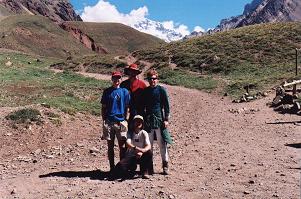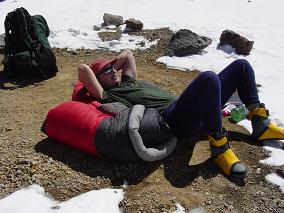
|
Expedition Members |

|
researched the question, "Who successfully climbs Aconcagua?" with an eye towards designing criteria for expedition membership. The most important factor is previous, successful ascents at very high altitude.
I judiciously assigned 17,000 feet as an appropriate cutoff (so including the Mexican volcanoes), and solicit applicants based on this value.
Edward Earl and I considered a team of four as ideal - two people sharing a tent and stove in each of two pairs.
Edward had met John Sype in 2003 on a commercially sponsored journey to the Ecuador volcanoes. After they co-summited Chimborazo, they agreed to join forces for scaling Aconcagua at some future date.
Edward composed a review of the expedition from his perspective.
John is a cardiologist who is just completing his formal training in Nebraska. John and his wife will shortly move to Colorado, so being closer to the mountains they BOTH enjoy.
Robert Greene is a county highpointer from central California. As he is intensely enthusiastic about the concept, and has climbed both Cotopaxi and Kilimanjaro, Robert fills the final, fourth spot on the team roster.
Robert's perspective of our adventure is described in his trip report.

|
|
All team members on Day 1. From reader's left: John Sype, Robert Greene, Edward Earl. Adam Helman sits in front; Aconcagua's south face looms in the background. |

|
s noted, multiple issues exist in the high altitude climbing arena, many of which form impediments to ultimate success.
In the following sections attention is focused in turn, upon the various issues faced when climbing Aconcagua. Special attention is lent to our expedition because it is the only one with which I am completely familiar.
As a preamble to these sections I quote John Sype when asked if he is appreciative of the opportunity to experience extremely high altitudes firsthand. His reply touches upon several of the issues discussed.
"The question of "Why do you climb mountains John?" has of course been asked (as I'm sure it has been of you and almost all mountaineers through the ages). My answer is difficult to put into words, but is most explained by a list of emotions and experiences that I encounter when I climb (listed in order of importance):
When I climb, this list is not partitioned out into separate "steps" or parts of the climb. Instead they're all rolled up into one large driving force that keeps me motivated and happy -- almost like a cloud or aura that surrounds me. In fact, I've almost pictured it as such when I reflect back on many of my climbs. This is what keeps me going back to the mountains."
In a private, post-expedition E-mail message John adds the following remarks.
"The other video [apart from the summit eulogy] that was filmed on the summit was of myself -- taken by Edward. I did not send that to anyone else. I've looked at that a few times as well. My wife watched it once and won't watch it again. She says I sound funny - -like I'm struggling to stay alive or that I seem injured. In retrospect, I am quite out of breath when I am speaking on the video.
Even though I still felt strong and did not feel too "hypoxic" on the summit, obviously at nearly 23,000 feet I am nontheless affected by the lack of oxygen. It reinforces the fact that, although this was a non-technical route up the Western Hemisphere's highest peak, it was still a very physically demanding and mentally challenging climb.
We were at EXTREME high altitude -- an altitude where human beings are not meant to really travel and certainly not live. This was not a mountain to be climbed on a whim. It required extensive planning and strict adherance to an acclimatization schedule. Failure to do either would not have only resulted in an inability to summit, but could have been fatal -- seriously.
We realized our ultimate goal through teamwork and focussing on the task at hand. In a sense, we had to approach this mountain with a certain type of military precision -- and we succeeded because we all were motivated and willing to pursue this goal as long as our bodies and Mother Nature allowed us.
Of course, my colleagues are extremely fascinated by my trip and I've shown a select few my photos. I try to put into words the experiences on the mountain. But no matter how much I try, it is impossible to relate the trip as I truly experienced it. As they say, YOU HAD TO BE THERE!! to truly understand."
Clearly John is quite pleased with our three week, vertically oriented vacation.

|
|
John rests during a lazy hour at our Lower Condores camp (17,600 feet). |
| previous page - Expedition Dates and Acclimatization Schedule | next page - Physical Considerations |